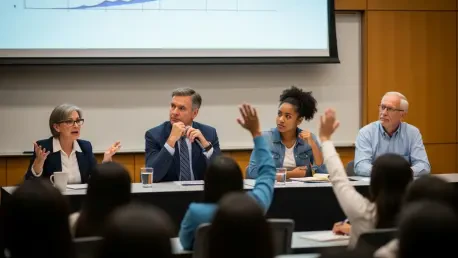Imagine a state where the future of thousands of students hangs in the balance, as political leaders clash over whether public schools should remain the bedrock of education or if public funds should flow toward private institutions. In Virginia, this scenario is unfolding with intensity as Democrats launch sharp criticisms against Lieutenant Governor Winsome Earle-Sears, the Republican nominee for governor, over her education policies. This heated debate, centered on funding, recovery, and the very essence of public education, has emerged as a defining issue in the gubernatorial election. The stakes are high, with implications not just for classrooms but for the broader values that shape Virginia’s political landscape.
Setting the Stage: A Heated Debate in Virginia Politics
Education has become a lightning rod in Virginia’s political arena, igniting passionate arguments as the gubernatorial election looms. Democrats have positioned themselves as staunch defenders of public schools, accusing Earle-Sears of advocating policies that could dismantle decades of progress in equitable education access. This conflict is more than a policy disagreement; it resonates deeply with voters who see education as a cornerstone of community and opportunity.
The significance of this debate extends beyond party lines, touching on fundamental questions about how resources are allocated and who gets to decide the direction of learning. With public education often cited as a top voter priority, the outcome of this clash could sway undecided constituents and redefine political alliances in the state. As both sides dig in, the rhetoric has grown sharper, reflecting broader national tensions over the role of government in schooling.
This escalating feud also mirrors a critical moment for Virginia, where economic and social recovery from past challenges like the COVID-19 pandemic remains unfinished. Education policy is not just about budgets; it’s about shaping the next generation and ensuring that no child is left behind in a rapidly changing world. The battle lines are drawn, and the implications are profound for every family in the Commonwealth.
Background on Winsome Earle-Sears and Education Policy Context
Winsome Earle-Sears, serving as Virginia’s Lieutenant Governor under Governor Glenn Youngkin, has risen as a prominent figure in Republican politics with her nomination for governor. Known for her historic role as the first Black woman elected to statewide office in Virginia, her tenure has been marked by a strong conservative stance on various issues, including education. Her platform has drawn both admiration and ire, positioning her as a polarizing force in state politics.
Education in Virginia has long faced complex challenges, from disparities in funding across districts to the lingering effects of pandemic-related disruptions. Historically, the state has grappled with balancing local control and state oversight, often leaving rural and underfunded schools at a disadvantage. Recent years have seen efforts to bolster public school budgets, but these gains remain fragile amidst competing priorities and economic constraints.
Currently, the education landscape is at a crossroads, with post-pandemic recovery exposing gaps in student achievement, particularly in math and reading. These issues form the backdrop against which Earle-Sears’s policies are being scrutinized. As debates over funding and curriculum intensify, her vision for reform has sparked a firestorm of opposition from those who fear it prioritizes private interests over public good.
Key Criticisms from Democrats on Earle-Sears’s Education Stance
Virginia Democrats have unleashed a barrage of critiques against Earle-Sears, centering on what they see as a direct assault on public education. They argue that her policies threaten to siphon vital resources away from schools that serve the majority of the state’s children, creating a system where access to quality education depends on wealth or privilege. This concern has galvanized party leaders to speak out with urgency.
The intensity of these criticisms is evident in public statements that paint Earle-Sears as out of touch with the needs of everyday families. Democratic leaders have rallied around the narrative that her approach could undo years of hard-fought progress in ensuring that every child, regardless of background, has a fair shot at success. This issue strikes a chord with many voters, amplifying the stakes as the election nears.
Specific examples of policy disagreements have fueled this fire, with Democrats citing proposed budgets and legislative priorities under the current administration as evidence of misplaced focus. Their pointed accusations aim to frame Earle-Sears as a risk to the future of Virginia’s students, making education a battleground issue that could define the campaign.
Threat to Public Education Funding
One of the most vocal concerns from Democrats revolves around Earle-Sears’s apparent support for diverting public funds to private schools. Senator Creigh Deeds has been outspoken, warning that such a move jeopardizes the state’s commitment to universal education by undermining the financial stability of public institutions. He argues that progress made in recent legislative sessions to protect school budgets is now at grave risk.
Delegate Amy Laufer echoes this sentiment, pointing to specific funding reductions under Governor Youngkin’s administration, where Earle-Sears serves, as a troubling precedent. She contends that prioritizing private school vouchers or tax credits over public school needs creates a dangerous precedent, potentially widening inequality across districts. Her critique underscores a fear that many communities could be left behind.
This issue of funding allocation is not merely academic; it touches on real-world consequences for teachers’ salaries, classroom resources, and extracurricular programs. Democrats assert that Earle-Sears’s vision fails to address these practical concerns, instead favoring an ideological shift that could reshape education in ways many families cannot afford.
Alignment with Controversial Federal Policies
Another sharp point of contention is Earle-Sears’s perceived alignment with federal policies that Democrats deem harmful to public education. Critics, including Laufer, have highlighted her endorsement of ideas similar to former President Donald Trump’s push to dismantle the Department of Education. They argue that such a stance signals a willingness to erode federal support structures critical for underfunded schools.
This alignment raises alarms about the potential for Virginia to adopt policies that diminish oversight and accountability at a time when consistency is desperately needed. Democrats warn that embracing these federal-level proposals could lead to chaos in state education systems, leaving local districts without the guidance or resources to navigate complex challenges.
The broader implication of this critique is a fear of losing a unified approach to education that prioritizes national standards and equity. By tying Earle-Sears to controversial national figures, Democrats aim to cast doubt on her commitment to Virginia-specific needs, framing her as more ideologue than problem-solver.
Failure in Post-COVID-19 Recovery
Delegate Katrina Callsen, drawing on her background as a teacher and school board member, has criticized the administration’s handling of post-pandemic recovery, placing part of the blame on Earle-Sears’s influence. She cites Virginia’s dismal national rankings—last in middle school math and 41st in reading recovery—as proof of inadequate support for students reeling from learning loss.
Her argument centers on the lack of targeted funding and programs to address these gaps, suggesting that the current leadership has failed to prioritize academic restoration over other agendas. Callsen’s firsthand experience in education lends weight to her claim that more could have been done to help students bounce back from unprecedented disruptions.
This critique resonates with parents and educators who have witnessed firsthand the struggles of children adapting to post-pandemic learning environments. Democrats leverage these statistics to argue that Earle-Sears’s policies offer no clear path to recovery, instead risking further setbacks for an already vulnerable student population.
Earle-Sears’s Education Vision and Republican Perspective
Earle-Sears has articulated a vision for education that emphasizes parental choice, advocating for policies that allow public funds to follow students to private or alternative schooling options. Her campaign platform frames this as a way to empower families, particularly those in underperforming districts, to seek better opportunities regardless of zip code or income level. This approach has become a cornerstone of her appeal to conservative voters.
Alongside her, Republican Lieutenant Governor nominee John Reid reinforces this perspective, supporting mechanisms like tax credits and vouchers to facilitate private school access. He has also critiqued public education for lacking discipline and effective curricula, proposing measures such as school uniforms and resource officers to restore order. These ideas are presented as pragmatic solutions to systemic failures.
Republicans argue that the current public school system is not meeting the needs of all students, pointing to persistent achievement gaps and parental dissatisfaction. Earle-Sears and Reid position their reforms as a necessary shake-up, designed to prioritize student outcomes over bureaucratic inertia, even if it means challenging long-standing funding models.
Current State of the Debate and Campaign Dynamics
As the election approaches, the education debate remains unresolved, with Earle-Sears’s campaign yet to directly address the flurry of Democratic criticisms. Instead, her public statements and social media activity have often pivoted to other topics, such as cultural issues in specific counties, suggesting a strategic focus on different voter concerns. This silence on education has left opponents to shape the narrative unchallenged.
Democrats continue to press their case, emphasizing academic funding and post-pandemic recovery as non-negotiable priorities. Their messaging is laser-focused on the tangible impacts of policy decisions, from classroom sizes to teacher retention, aiming to connect with families who feel the strain of underfunded schools.
In contrast, Republican priorities appear to blend educational reform with broader cultural battles, reflecting a divide in how each party approaches the electorate. While Democrats frame education as a matter of equity and investment, Earle-Sears and her allies seem to lean on systemic critique and social conservatism, creating a stark contrast in campaign dynamics as the race tightens.
Reflection and Broader Impacts
The education policy debate in Virginia encapsulates a microcosm of national struggles over public versus private schooling, with far-reaching consequences for voter sentiment. It serves as a litmus test for how much residents value traditional public education against calls for innovation and choice, potentially influencing turnout and party loyalty in the upcoming election.
Reflection
Democrats present a compelling case for safeguarding public schools, rooted in a belief that equitable access is a societal imperative; yet, they face the hurdle of countering Republican narratives that paint public systems as failing. Earle-Sears’s proposals, while risky in their potential to deepen inequality, carry an appeal for parents frustrated with status quo limitations, offering a vision of flexibility that resonates with some.
Balancing these perspectives reveals a nuanced challenge: protecting public education’s foundational role while addressing legitimate critiques of its shortcomings. The strength of Democratic arguments lies in data and historical commitment, but Republicans tap into a growing desire for alternatives, making this a debate of ideals as much as policy specifics.
Broader Impact
Looking at long-term effects, the outcome of this policy clash could reshape Virginia’s education system, impacting student outcomes and equity for years to come. A shift toward privatization risks widening gaps between affluent and disadvantaged communities, while sustained public investment could strengthen systemic resilience if adequately funded.
Nationally, Virginia’s struggle could set precedents for other states grappling with similar issues, influencing how policymakers approach the balance between government involvement and individual choice. The ripple effects might extend to federal education priorities, highlighting the Commonwealth’s role as a battleground for defining the future of American schooling.
Looking Ahead: The Future of Education in Virginia
The core dispute between Virginia Democrats and Winsome Earle-Sears hinges on divergent visions for education—whether to fortify public schools as a universal right or to reallocate resources toward private options under the banner of choice. This issue stands as a critical determinant of the state’s trajectory, affecting not just students but the fabric of communities reliant on robust educational systems.
As the gubernatorial election draws near, the importance of staying informed on these policy differences cannot be overstated. Education remains a pivotal arena where values and priorities collide, offering a window into broader governance philosophies. Engaging with candidate platforms and local school board discussions can empower voters to shape an outcome that aligns with their vision for Virginia’s future.









